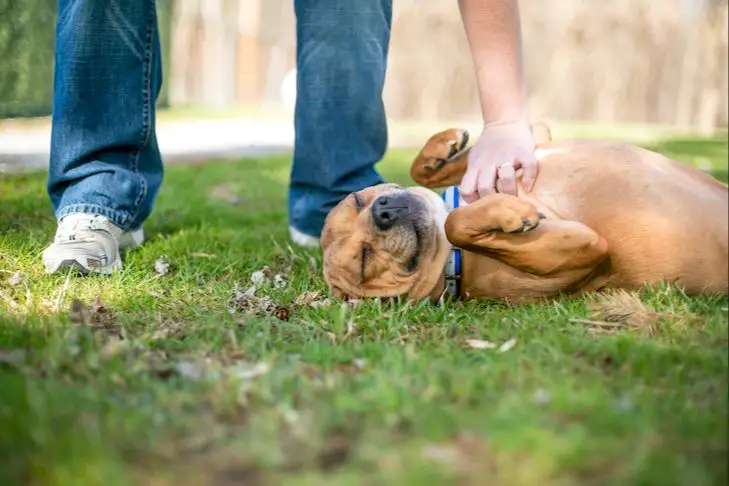Why Do Dogs Lie on Their Backs?
If you’ve ever seen your dog lying on their back with their legs in the air, you may have wondered what motivates this silly and endearing position. There are a few theories behind why dogs lie on their backs that range from the practical to the downright adorable.
In this article, we’ll explore some of the most common reasons dogs end up on their backs. We’ll look at theories like comfort, cooling off, submission, and playfulness. We’ll also examine factors like breed, age, and personality that may influence the behavior. Finally, we’ll provide some training tips for managing this habit in situations where it’s not ideal.
By the end, you’ll have a better understanding of this quirky canine behavior and whether it’s something to encourage or redirect.
Common Theories
There are a few common theories as to why dogs lie on their backs with their legs in the air:
Submission Theory
One theory is that lying on their back is a sign of submission, with the belly exposed as a vulnerable area. Dogs may show their belly to demonstrate submission to a dominant dog or owner, signaling they are not a threat.

Comfort Theory
Many experts think dogs simply find lying on their backs very comfortable and relaxing. The posture allows their spine to elongate and their back muscles to release tension. It’s a comfortable position that enables restful sleep (McDermott 2022).
Cooling Theory
Lying on their backs can help dogs cool off, especially if their belly is exposed. Their paws have sweat glands that allow heat to release when up in the air. The belly fur is thinner and allows for improved air circulation (Roberts 2022).
Play Theory
When a dog flips on their back during play, it’s often an invitation for more play and belly rubs. The posture signals they are open to playful interaction. However, owners should be careful about reaching for the belly uninvited (McMillan 2013).
Submission Theory
One of the most common theories for why dogs lie on their backs is that it’s a passive posture that shows submissiveness and a lack of threat. Wolves and wild dogs naturally show submission to more dominant members of the pack by rolling over and exposing their belly. This helps avoid conflict and signals that they know their place in the hierarchy. Dogs inherited this instinct from their ancestors. The canine behavior expert Dr. Sophia Yin states, “Dogs today retain some instinctual behaviors that were inherited from wolves; themost common is the submissive posture.”
When pet dogs roll over to expose their belly to their owners, it can signify that they accept humans as the pack leader. According to Pawsitive Pets, “When your dog rolls on their back when you are around, they are performing an appeasement behavior. It signifies a complete lack of threat.” So in many cases, dogs do this to gain affection and approval from their owners. Showing their belly demonstrates trust, respect, and submission.
Sources:
https://www.vetstreet.com/our-pet-experts/7-signs-of-submissive-behavior-in-dogs-photo-gallery
https://www.thesprucepets.com/submissive-dog-behaviors-5189855
Comfort Theory

One common theory is that dogs lie on their backs because it’s comfortable for them. The supine position allows their muscles to relax and gently stretches their spine and joints (1). When dogs sleep on their backs with their legs in the air, they are completely stretched out and able to fully relax all their muscles simultaneously (2). This may feel especially good after a long walk or vigorous play session. The supine position also allows air to circulate around their belly, which can help them cool down.
Dogs that sleep on their backs are essentially saying “I feel safe and comfortable enough in this environment to completely expose my belly.” It’s a sign that they trust their surroundings and don’t feel vulnerable. When dogs sleep in this position, it means they feel secure and happy.
Cooling Theory
Many experts believe dogs sleep on their backs to help regulate their body temperature and cool down Why Does My Dog Sleep On Their Back? – American Kennel Club. Dogs do not have sweat glands like humans do. Instead, dogs cool themselves through their paw pads and by panting Why Dogs Sleep On Their Backs – Southern Living.
When a dog flips over onto their back, it exposes their belly and groin area, allowing heat to radiate off their body. Their paws also have sweat glands that can cool the body. By sleeping in this position, the air can more effectively circulate around the dog’s body and dissipate heat.
Many dogs will sleep on their backs during hot summer months or in warm environments. The back-sleeping position helps them maximize cooling effects.
Play Theory
One common theory for why dogs roll onto their backs is that they are inviting their owners to play or interact. When a dog rolls onto their back with their legs in the air, it can be a playful posture that signals they want attention and playtime. This is likely an inherited behavior from their wolf ancestors, who used this posture to invite their packmates to play.

Dogs may roll onto their backs as a way to get attention from their owners. Exposing their belly is a vulnerable position that shows trust, while also being an amusing posture that makes their owners more likely to engage with them. It can prompt owners to rub the dog’s belly or initiate play.
While this theory is commonly cited, there has been limited specific research into back-lying as an invitation for play. However, it aligns with dogs’ playful nature and use of body language for communication. Context clues like a wagging tail, excited panting, and play bows can indicate a dog is seeking play when rolling onto their back.
Individual Factors
An individual dog’s breed, personality, and environment can all influence its tendency to sleep on its back with legs in the air.
Certain breeds like the Samoyed and Siberian Husky, with their thick double coats, often sleep on their backs to help regulate their body temperature. The exposed belly fur provides additional cooling. Small breeds like the Chihuahua also find sleeping on their backs comfortable (Dogtime).
A dog’s unique personality plays a role as well. Confident, relaxed dogs are more likely to sleep in this position. Shy, anxious dogs tend to curl up in a ball instead. An alpha dog that sees itself as the leader of its human pack may sleep on its back to show its dominance (Yeti).
Finally, a dog’s environment impacts its sleep habits. Dogs that sleep indoors, especially in air conditioning, are more prone to sleeping on their backs to cool down. Outdoor dogs may choose different sleep positions to regulate their temperature and watch for predators.
When to Worry
While dogs sleeping on their backs is generally harmless, there are some signs to watch out for that may indicate a medical issue:
Signs of distress – If your dog appears anxious, uncomfortable or unable to get back up when lying on their back, this could signal a problem. Signs of distress include crying, whining, rapid breathing, trembling, restlessness or other agitated behavior.
Duration and frequency – Most dogs will only spend short periods of time sleeping on their backs. If your dog is lying on their back for prolonged periods or doing so more frequently than usual, it could point to an underlying condition. Any significant change in sleeping positions warrants attention.
Veterinary advice – If your dog shows signs of distress when on their back or spends excessive time in this position, consult your veterinarian. They can examine your dog for conditions like bloat, arthritis, spinal problems or neurological issues that may be causing discomfort. Your vet can also advise on whether additional testing or treatment is needed.
Training Considerations
Reinforcement is a key part of training a dog to lie on their back. When your dog offers the behavior, reward them with praise, treats or play to mark it as a desired behavior. Work up from easier durations like holding the position briefly to longer times lying on their back as the behavior strengthens. Set the criteria and reward the increments you want to see. Never force or punish physically when training this or any behavior; it will likely backfire.
If your dog is uncomfortable lying fully on their back, encourage alternatives like rolling to their side or lying with their legs upright. Work up to full back lying gradually, shaping closer approximations over many short sessions. Stay positive throughout. Other relaxed positions like down, sit or rollover can satisfy a dog’s enjoyment of belly rubs. Reinforce any offered behavior that shows your dog is willingly engaging in play or bonding with you.

Conclusion
In summary, there are several common theories as to why dogs lie on their backs with their legs in the air. The submission theory suggests it’s a sign of trust and feeling safe. The comfort theory proposes dogs find it relaxing and soothing. The cooling theory points to dogs using the position to regulate their temperature. And the play theory relates it to showing playfulness and wanting engagement.
While the behavior stems from natural canine instincts, factors like breed, age, personality, and training can influence when and how often a dog assumes this position. It’s generally not a cause for concern unless it happens suddenly, frequently, or is accompanied by signs of illness. With proper training and setting reasonable boundaries, the behavior can be managed.
Overall, lying on their back with legs up is a common dog behavior arising from multiple innate causes. By understanding the various theories behind it, owners can better interpret what prompts their own dog to sleep or rest in this curious but endearing position.